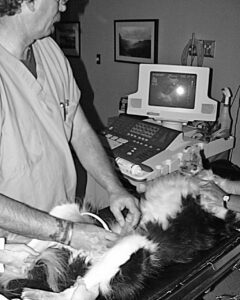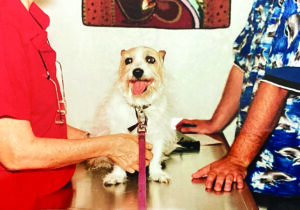Whole Dog Journal is reader-supported. If you purchase through links on our site, we may earn a commission.
Urinary tract infections (UTIs) are a common phenomenon in dogs. In the case of UTIs, “infection” means that bacteria have gained access to the urinary tract, are multiplying in there, and causing painful symptoms for the dog.
Anatomy of a Dog UTI

The dog’s urinary tract starts with the kidneys, where urine is produced. The urine then travels down tubes (ureters) into the bladder and exits the body through the urethra.
When someone uses the phrase “UTI,” they could mean infection in any one of these parts of the urinary tract. Usually, “UTI” is meant to indicate a bladder infection (bacterial cystitis, also called a called a “lower UTI”), as this is the most common place for infection to occur.
When the kidneys get infected (“upper UTI”) the dog is typically much sicker and has totally different symptoms. Our focus here is specifically on lower UTIs or bacterial cystitis.
UTIs are fairly common, especially in female dogs, who suffer far more than male dogs due to simple anatomy: The opening for urine to exit the body is a lot larger in females than males, which means it’s a lot easier for bacteria to gain entrance to the urinary tract.
This anatomical difference may seem like a curse for the girls, but it’s also a blessing, as it’s extremely rare for female dogs to suffer life-threatening urinary blockages due to the wider opening. Urinary blockage caused by bladder stones is far more common in male dogs. So, we take the good with the bad for our girls.
How to Tell If Your Dog Has a UTI
Dog UTI symptoms are similar in female and male dogs. UTI symptoms include:
- Frequent need to urinate (pollakiuria)
- Urinating only small amounts at a time
- Discomfort while urinating (dysuria)
- Straining to urinate (stranguria)
- Bloody urine (hematuria)
- Excessive water consumption (polydipsia)
- Inappropriate urination (i.e., urinating in the house, lapse in house training)
- Leaking urine (urinary incontinence)
- Excessive or compulsive licking of the external genital area.
If the infection stays localized to the bladder and is appropriately treated in a timely fashion, dogs with bladder infections typically don’t get sick with advanced symptoms like loss of appetite, lethargy, or vomiting. They are usually just uncomfortable with any or all of the above dog UTI symptoms.
How is a UTI Diagnosed in Dogs?
A urinalysis is essential for diagnosing a UTI. Bring a fresh urine specimen with you to your veterinary appointment. Be sure whatever container you use is clean and dry. The fresher the sample, the better the information for your veterinarian. Catching one right outside the hospital before you go in would be best. If you catch one at home before your appointment, be sure to refrigerate it.

If your dog has been diagnosed with a UTI previously and you suspect another, your veterinarian may want to retrieve a sterile sample directly from your dog’s bladder. Be sure to ask if you should bring a urine specimen, or just bring your dog with a full bladder.
A thorough physical exam is important for any dog presenting with signs of a UTI. Your veterinarian will carefully examine your dog, checking for any evidence of underlying issues and concurrent disease. If the physical exam is good and the urinalysis shows evidence of infection, most veterinarians are comfortable treating for a UTI based on these findings alone.
It’s important to understand that the urinalysis and physical exam allow your veterinarian to make a presumptive diagnosis only. The only way to definitely diagnose a bacterial infection of the urinary tract is with a urine culture. When urine is cultured in a laboratory, culture medium is used to grow any bacteria present in the sample. The organism can then be identified and tested in order to discover which antibiotic will be most effective for treating it.
How to Handle Recurrent UTIs in Dogs
The natural anatomy of female dogs makes them more prone to UTIs. Dogs who respond well to treatment for their first UTI usually don’t need any further exploration. But if any dog, male or female, develops a second, third, or more UTIs, it’s time to start looking for underlying causes.
It’s equally important to differentiate whether repeat sufferers are having relapses from a persistent, unresolved infection or true reinfection. Reculturing urine at the end of antibiotic treatment is the only way to definitively ascertain that a UTI has fully resolved.
In female dogs, one of the biggest causes of recurrent UTI involves the condition of her external genitalia or vulva. A normal healthy vulva is V-shaped, with edges that are fairly flush with the surrounding skin.
Many female dogs have recessed vulvas, sometimes called juvenile vulva, where the vulva is tucked in behind folds of surrounding skin. This anatomy provides a perfect environment for bacteria to go wild, right near the opening to the urinary tract.
Some females have a hooded vulva – a big skin fold forming a roof over the vulva – with the same result. Obese females are prone to developing deep skin folds and recesses around the vulva, even if they started life with normal vulvar anatomy. The treatment for aberrant vulvar conformation resulting in recurrent UTIs is a surgical correction called a vulvoplasty.
Other causes of recurrent UTIs in dogs include:
- Bladder stones
- Bladder polyps or tumors
- Urinary crystals
- Antibiotic resistant infection
- Stopping antibiotic treatment too soon
- Unresolved, persistent, original infection
- Immune-compromised patient
- Concurrent metabolic disease predisposing to UTI (e.g., diabetes, Cushing’s Syndrome)
- Urinary incontinence (urethral sphincter mechanism incompetence)
- Prostatic disease in older, unneutered male dogs
If your dog suffers from recurrent UTIs, further testing will likely be recommended including but not limited to:
- Full bloodwork
- Repeat urine cultures
- Abdominal x-ray
- Abdominal ultrasound
- Cystoscopy (endoscopic visualization of the bladder)
- Bladder biopsy
If an underlying cause is diagnosed and corrected, your dog should stop developing recurrent UTIs.
The Only Dog UTI Treatment
This is pretty simple: UTIs require treatment with antibiotics. Choosing the best antibiotic and treating the infection long enough are critical to successfully returning the dog to an infection-free state.
“How long” is “long enough” is for your veterinarian to decide. There is ongoing research to see exactly how many days of antibiotic treatment is really necessary. Most veterinary practitioners recommend 14 days of antibiotic therapy, with a follow-up urinalysis and/or culture at the end.
At Home Treatment for UTIs in Dogs
Because it’s a bacterial infection requiring treatment with antibiotics, you may not be successful clearing an active infection on your own. There are, however, supportive things you can do at home to help your infected dog, and plenty of preventive measures you can take to avoid or lessen the potential for a UTI in your dog. Here are my suggestions:
- Make sure fresh water is always available. If you feed dry kibble, consider adding water and/or some canned food to your dog’s diet. Fluid ingestion helps keep things moving through the urinary tract, flushing out any bacteria that’s trying to get a foothold and helping maintain a healthy environment in the bladder.
- Afford your dog the opportunity to empty his or her bladder as frequently as possible. When urine sits in the bladder for extended periods of time (“urine stasis”), it gives bacteria more opportunity to take hold. An extra potty break at midday would help!
- If your female dog is overweight, get the weight off! This will help prevent a recessed vulva from serving up bacteria to the urinary tract.
- Perform daily hygienic cleansing of your female dog’s perivulvar area. Wet baby wipes work well. Be sure to get into any deep folds or crevices surrounding the vulva.
- If your older, unneutered male dog has had a UTI, get him neutered! This will help with prostatic disease, which is likely the underlying cause.
- If your female dog suffers from spay incontinence, seek treatment for this. Incontinent dogs have weak sphincters, which opens the door wider for bacterial invasion.
- If your dog has been identified as one who forms urinary crystals, follow your veterinarian’s advice regarding the best preventative diet.
- Consider putting your dog on a probiotic. Probiotics strengthen the dog’s immune system, which helps fight off UTIs and may even make the vaginal and preputial bacterial population healthier.
- Cranberry extract may help prevent some UTIs. It works not by acidifying the urine as most people think, but by inhibiting certain bacteria’s ability to stick to the bladder wall. Crananidin (made by Nutramax) is a popular veterinary product for this purpose.







Good read and the tips, especially how the cranberry extract works
Also I didn’t know you could give probiotics to dogs, I thought they’d need different bacteria to humans or is there probiotics specifically for dogs?